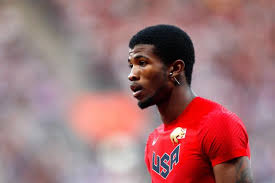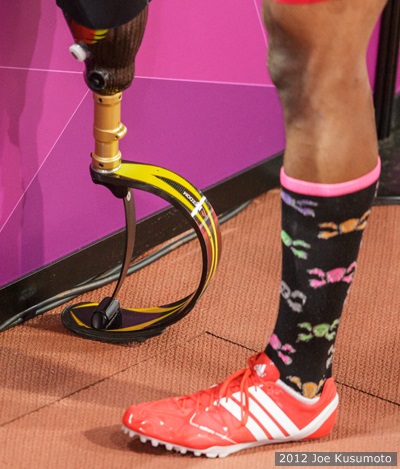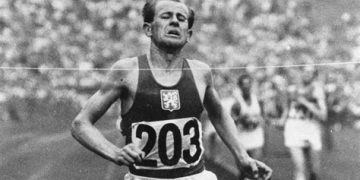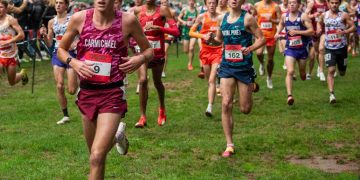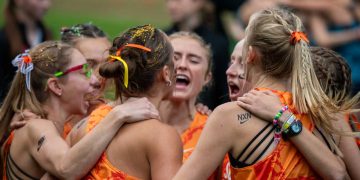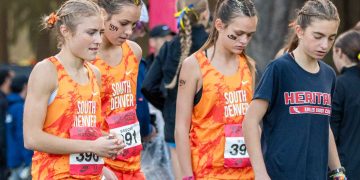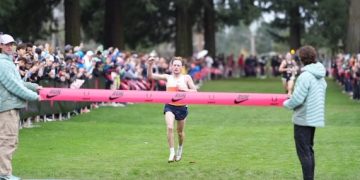Richard Browne, photo courtesy of Paralympics USA
Elliott Denman wrote this piece a few months ago. Last week, he reminded me of the piece and I took the time to read it, and really understood why Elliott wanted us to know about this very amazing athlete.
Richard Browne is the least know world record setter!
By ELLIOTT DENMAN
Brooklyn Dodgers; Brooklyn Nets; Brooklyn, New York.
Richard Browne loves everything about New York City’s most populous borough.
It is, after all, the hometown of his wife, Wennie, and now the first name of their bouncing baby daughter.
In one of his sport’s most precious moments, Richard Browne, cradling seven-month-old daughter Brooklyn in his arms, dashed up to the Anaheim Hilton Hotel ballroom stage to be saluted as USA Track and Field’s Para-Athlete of the Year a few weeks before 2014 turned into 2015.
Last year was sensational for Browne – who runs with a highest-tech prosthetic blade on his right lower leg, after surviving a horrific accident in 2007. He gained recognition not only as America’s but the world’s fastest Paralympic sprinter.
But he’s still the nation’s least known world record-setter – hoping for a big change in that status in 2015.
The 23-year-old went undefeated in 2014 with a string of world records to his credit and now yearns to test his speed against the fastest fully able-bodied runners on the planet. Meet directors are already on notice. He’s ready, willing and more than able to take on the best. The ball is in the directors’ courts now. He awaits their invitations.
Sure he hopes to flash his skills in the biggest of all meets, but he doesn’t want to be treated as a curiosity, either.
In Paralympic competition, he runs in the T44 category, as a below-the-knee amputee.
Richard Browne, photo courtesy of Joe Kusumoto
“I was in a really bad accident,” he tells you. “After that, I had 10 surgeries.
Finally, I came to the decision on my own and with my family that it was best to go ahead and have it cut off.
“It was a just a freaky accident that caused it. I was raised in Atlanta, Georgia, but this happened in Jackson, Mississippi, where my family was originally from. It was raining really bad one day, I was running to get out of the rain, and I just slipped on the sidewalk and went through a plate glass window. I crashed through it and cut veins, arteries, some nerves and I don’t know how much more.
“It was just a one-in-a-million thing, and next time it does happen it probably won’t happen the same way it happened to me. It was absolutely freaky.
“Rain in Mississippi or most places back in the south isn’t like rain in California or anywhere else. It was absolutely pouring down. I just didn’t want to get wet. “
“Sure it was a traumatic situation but I had family around me to pull me through, and now I have track and field.”
He’d never been a track and field athlete before it happened. Football had
always been his game. But track and field proved the best kind of therapy as he rehabbed through the ordeal and soon it became a whole lot more than therapy.
Call the tracks of the world his path to a whole new outlook on life and recognition as a world-class athlete.
Attending Tucker High School and then Morehouse College in Atlanta, he
built a golden athletic future despite his disability. Morehouse, of course, is the alma mater of Edwin Moses, the two-time Olympic champion and
world record-setting 400-meter hurdler.
“The Edwin Moses track is there on campus now – he helped endow it – and
that’s where I trained,” said Browne. “He comes back for the Morehouse Relays just about every year and, of course, he’s one of those persons we all look up to.When you win 152 races in a row and go down as the greatest runner of all time,it’s pretty obvious why.
“Honestly, track was just one of those things I discovered. I didn’t know anything at all about the Paralympics when I lost my leg.
“The person (Brett Lee of Pro-Care Prosthetics and Orthotics of Jackson, Mississippi) who made my (prosthetic) leg showed me a running blade and I tried it out, and pretty soon I found out I could be pretty good at track, too.
“Brett’s an amazing person; he turned my life around.”
Equipped with his new leg, Browne embarked on a training regimen
and gradually worked into competitive form.
He can never forget his first race as a Paralympian.
“This was The Endeavor Games on the campus of the University of
Central Oklahoma and it was a showcase of all the Paralympic sports.
“Mine was track and I ran the 1, 2 and the 4 (100, 200 and 400 meters.).
“Not exactly sure, but I think I ran 56 in the 400, 23 in the 200, and 12 seconds-something in the 100. Pretty good, they told me, especially for a rookie, but I knew I could do a lot better.
“That seems so long ago.
Especially since I’m running a lot faster than that now.”
A lot-lot-lot faster.
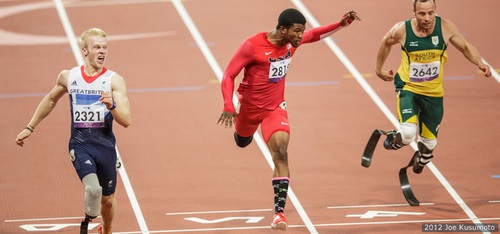
Richard Browne, photo courtesy of Joe Kusumoto
His personal records are now down to 6.99 for the indoor 60-meter dash,
10.75 for the outdoor 100, and 21.62 for the 200. The 400 remains a target waiting for him to attack.
In the summer of 2012, Browne became a USA Paralympian, getting the opportunity to compete at the same London Olympic Stadium the fully abled got to grace two weeks earlier. He came through with a silver medal in the 100-meter sprint.
What a race this was – Great Britain’s Jonathan “Jonnie” Peacock was the huge crowd favorite and fired out of the starting blocks for a big early lead. By 80 meters, though – with over 80,000 yelling and screaming (mostly for Peacock) – Browne was right on his shoulder.
Peacock eventually pulled out to a narrow lead and won in 10.90, setting a Paralympic record in the process, but Browne crossed the line in a PR of 11.03. Earlier in 2012, Peacock had lowered the world mark to 10.85.
He found the time to place fourth in the Paralympics high jump but lost another medal bid when the American team (like several in the “other” Games over the years) was disqualified in the 4×100 relay for a baton infraction.
“I’m the guy that caused that (the DQ), too,” he admits. “I stepped on the (zone) line.”
By the 2013 season, though, Browne felt he was ready to burst through to the top.
Competing at the IPC (International Paralympic Committee) Championships in Lyon, France, Browne lowered the world 100-meter record with a 10.83 clocking in the semifinals. Only problem was that Peacock again beat him in the final.
But Browne did win a gold medal as a member of USA’s victorious 4×100 relay team.
That 2013 indoor season also saw Browne cut the 60-meter world record to 6.99 at the Emory Crossplex Invitational Meet in Birmingham, Alabama.
The biggest meets of 2014 saw Browne winning the 60 meters at the International Five-Nation Match in Glasgow, Scotland, then twice chopping down the world 200-meter mark (as first T44 runner under 22 seconds.)
First, he ran 21.91 at the Mount San Antonio College Relays in California in April, then he sped 21.62 at the famed Van Damme Memorial Meet in Brussels, Belgium in early September.
“Sure, 2014 was a very good year for me,” he tells you, “but I want 2015 to be a whole lot better.
“I want to take some more off my 100-meter record, and I think I’m ready to go maybe 20.5 in the 200.”
Sure he was honored as America’s number one Paralympian at his nation’s biggest honors gathering – which featured presentation of the annual Jesse Owens award – but he’s still a virtually unknown to most of his countrymen.
“In America, (recognition in) track is still very small,” he laments. “But once you get on a plane and go somewhere else you’re treated with superstardom.
“In places like England, Belgium, Sweden, and others, too, I’m always asked for my autograph, to take pictures with people. The people there know who you are.
For the most part, here at home, I try to keep it low key but that’s OK, too.
“Whatever happens, though, it’s definitely a blessing. Never in a million years did I think I’d be traveling the world like I am now.”
Apart from lowering his PRs, he has two major targets for this year and the next.
“One, I want to make the cross-over to able-bodied running, the way Oscar
(Pistorius) did (the South African is in the T-43 category for double amputees.) He was the first to do it and got a lot of recognition, but unfortunately with his personal situation kind of put a bad taste in a lot of people’s mouths.
“Then, of course, there’s Rio DeJaneiro in 2016.
“It’s on everybody’s list, isn’t it?
“When I first became an amputee, I felt everything. (Once fitted with his prosthesis), it was so sensitive, it hurt a lot, all the time.
“But that’s way in the past for me. I’ve come so far I don’t even remember when I had two legs of my own.”
He’s hoping for an invitation to the Millrose Games at The Armory in New York on Feb. 14, then invites outdoors to the Prefontaine Classic and USA Nationals in Eugene, Oregon.
Later, he’s already booked for a meet in Japan, then Diamond League stops in Rome, Birmingham (England) and Brussels.
“We put on such a good show last year that people keep inviting us back,” he says.
“And that’s really fine with me.”
-
Larry Eder has had a 52-year involvement in the sport of athletics. Larry has experienced the sport as an athlete, coach, magazine publisher, and now, journalist and blogger. His first article, on Don Bowden, America's first sub-4 minute miler, was published in RW in 1983. Larry has published several magazines on athletics, from American Athletics to the U.S. version of Spikes magazine. He currently manages the content and marketing development of the RunningNetwork, The Shoe Addicts, and RunBlogRun. Of RunBlogRun, his daily pilgrimage with the sport, Larry says: "I have to admit, I love traveling to far away meets, writing about the sport I love, and the athletes I respect, for my readers at runblogrun.com, the most of anything I have ever done, except, maybe running itself." Also does some updates for BBC Sports at key events, which he truly enjoys.
Theme song: Greg Allman, " I'm no Angel."
View all posts



